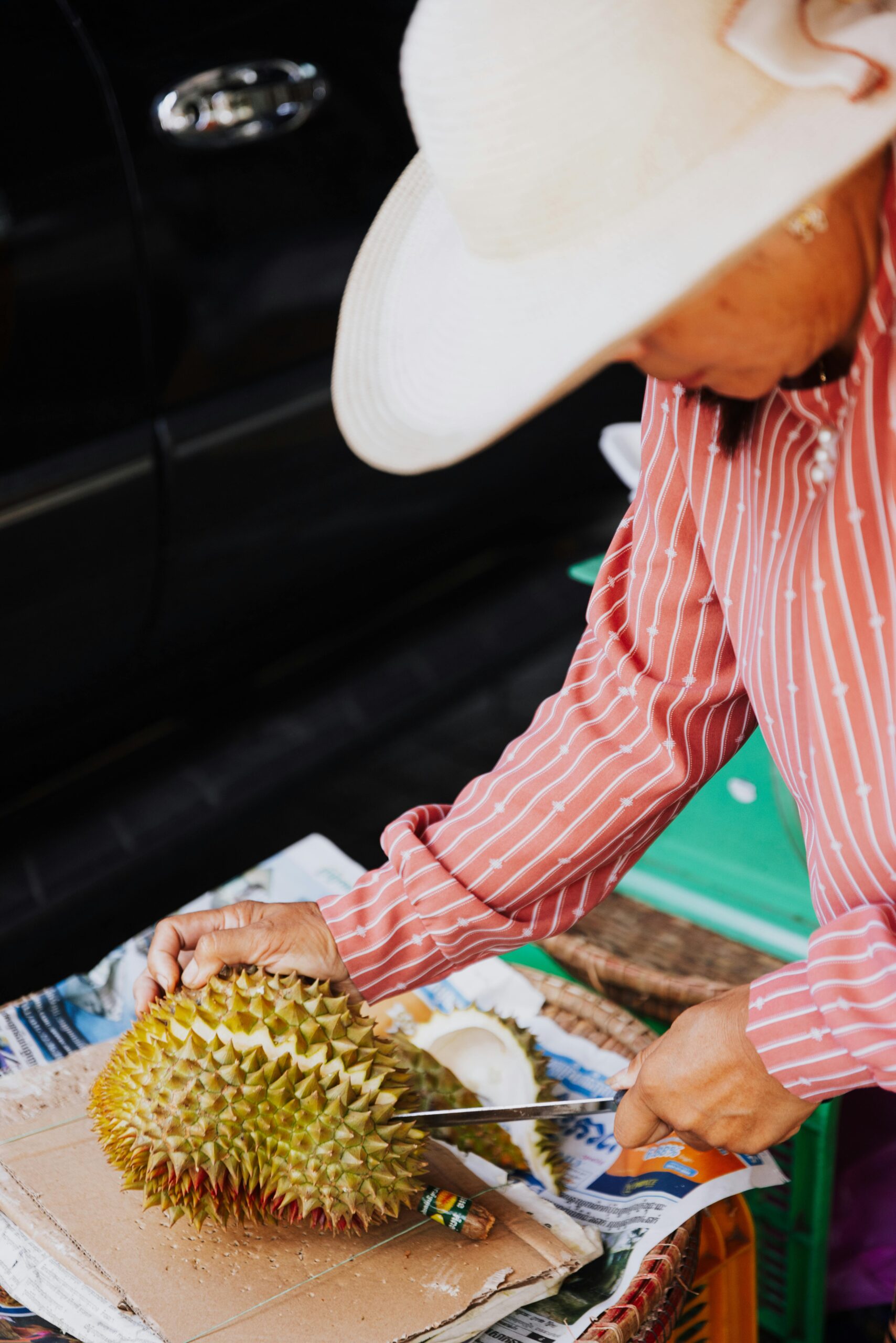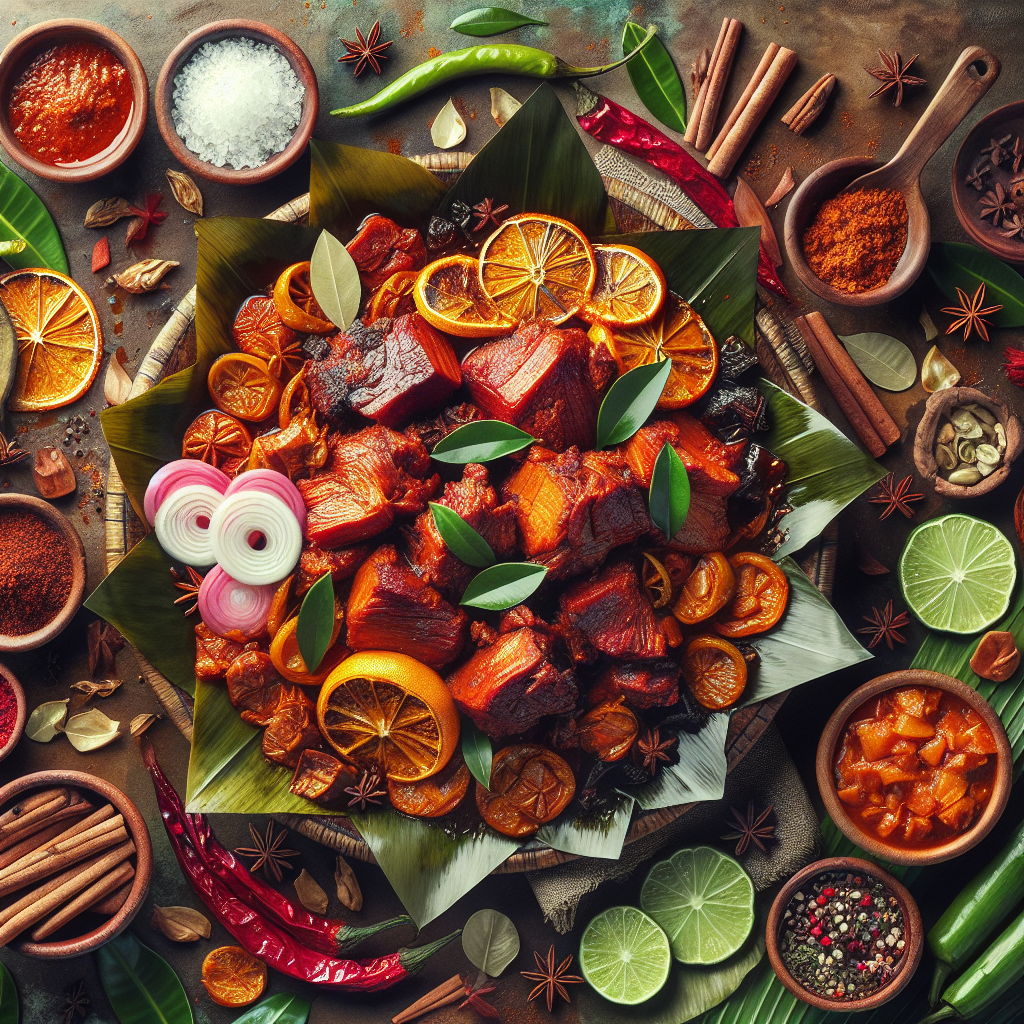Discover the vibrant and delicious flavors of Mexico’s Yucatan Peninsula as we embark on a gastronomic journey through its culinary heritage. From ancient Mayan traditions to a fusion of Spanish, Caribbean, and Lebanese influences, the Yucatan Peninsula is a melting pot of flavors waiting to be explored. Join us as we uncover the secrets behind famous dishes such as cochinita pibil, poc chuc, and sopa de lima, and learn about the ingredients and techniques that make Yucatecan cuisine unique. Get ready to tantalize your taste buds and dive into the rich tapestry of flavors that define this captivating region.

History of Yucatan Peninsula
The Yucatan Peninsula, located in southeastern Mexico, has a rich history that dates back to the Pre-Columbian era. Before the arrival of the Spanish colonizers, the region was inhabited by various indigenous communities, most notably the Mayans. The Mayans had a profound influence on the culture and cuisine of the Yucatan Peninsula, leaving behind a lasting legacy that can still be seen and tasted today. The colonial period, which began with the arrival of the Spanish in the 16th century, further shaped the culinary traditions of the region, introducing new ingredients and cooking techniques.
Pre-Columbian era
The Pre-Columbian era refers to the time before the arrival of Christopher Columbus in the Americas. In the Yucatan Peninsula, this period was dominated by the Mayan civilization, which thrived from around 2000 BC to the 16th century AD. The Mayans were skilled farmers and traders, known for their advanced agricultural practices and sophisticated trading networks. They cultivated staple crops such as corn, beans, and squash, which formed the foundation of their cuisine. The Mayans also traded with neighboring regions, allowing them to incorporate a wide variety of ingredients into their cooking.
Mayan influence
The Mayan influence on the cuisine of the Yucatan Peninsula is profound. Many of the traditional ingredients and cooking techniques used in Yucatecan cuisine can be traced back to the Mayans. The Mayans were known for their use of achiote, a vibrant red spice made from the seeds of the annatto tree. Achiote imparts a distinct earthy flavor and vivid orange color to dishes, making it a key ingredient in Yucatecan cooking. The Mayans also cultivated and consumed habanero peppers, one of the hottest chili peppers in the world. Habaneros are often used in marinades and sauces, adding a fiery kick to Yucatecan dishes.
Colonial period
The colonial period in the Yucatan Peninsula began with the arrival of the Spanish conquistadors in the 16th century. The Spanish introduced new ingredients and culinary techniques to the region, blending European and indigenous flavors. The Spanish brought citrus fruits, such as oranges and limes, which became integral to Yucatecan cuisine. The combination of citrus fruits and achiote resulted in the creation of iconic Yucatecan dishes like Sopa de Lima, a chicken soup flavored with lime juice and garnished with fried tortilla strips.
Key Ingredients and Flavors
Yucatecan cuisine is known for its robust flavors and creative use of ingredients. Here are some key ingredients that define the flavors of the region:
Achiote
Achiote, also known as annatto, is a spice made from the seeds of the annatto tree. It has a slightly peppery flavor and imparts a vibrant orange color to dishes. Achiote is commonly used in marinades, sauces, and spice pastes.
Habanero peppers
Habanero peppers are among the spiciest chili peppers in the world. Known for their intense heat and fruity flavor, they are used to add a fiery kick to Yucatecan dishes.
Citrus fruits
Citrus fruits, such as oranges and limes, play a prominent role in Yucatecan cuisine. They bring a refreshing acidity to dishes and are used in marinades, dressings, and beverages.
Corn
Corn is a staple ingredient in Yucatecan cuisine, just as it was for the Mayans. It is used in various forms, including tortillas, tamales, and soups.
Beans
Beans are a versatile and protein-rich ingredient in Yucatecan cooking. They are often cooked and served alongside other dishes or used as a filling for tacos and tamales.

Traditional Cooking Techniques
Yucatecan cuisine is characterized by its traditional cooking techniques, which have been passed down through generations. These techniques contribute to the unique flavors and textures of the region’s dishes. Some notable cooking techniques in Yucatan include:
Slow-roasting in pib
One traditional cooking technique in the Yucatan Peninsula is slow-roasting in a pib, a traditional Mayan earth oven. The pib is a pit dug into the ground and lined with stones. Food, such as pork or chicken, is wrapped in banana leaves and placed in the pib, where it slowly cooks in the smoky heat.
Use of chiles in marinades
Marinades are an integral part of Yucatecan cuisine, and chiles play a crucial role in them. Chiles, especially habaneros, are often used to create spicy and flavorful marinades that infuse meats with bold flavors.
Grilling over open flames
Grilling over open flames is a popular cooking technique in Yucatan. Meats, such as pork or chicken, are grilled over a wood fire, which imparts a smoky and charred flavor.
Preparing recados (spice pastes)
Recados are spice pastes made from a combination of spices, herbs, and sometimes achiote. These recados are used as a base for many Yucatecan dishes, adding depth and complexity of flavor.
Iconic Yucatecan Dishes
Yucatecan cuisine is renowned for its diverse range of mouth-watering dishes. Here are some of the most iconic Yucatecan dishes that you should try:
Poc Chuc
Poc Chuc is a traditional Yucatecan dish made with grilled pork marinated in citrus juices and achiote. It is typically served with pickled red onions and tortillas.
Cochinita Pibil
Cochinita Pibil is a traditional Yucatecan dish made with slow-roasted marinated pork. The pork is marinated in achiote, sour orange juice, and other spices, then wrapped in banana leaves and cooked in a pib. The result is tender, flavorful meat with a hint of smokiness.
Sopa de Lima
Sopa de Lima is a refreshing soup made with chicken broth, lime juice, and shredded chicken. It is garnished with fried tortilla strips and often served with avocado and cilantro.
Huevos Motuleños
Huevos Motuleños is a hearty Yucatecan breakfast dish. It consists of fried eggs served on a bed of refried beans, topped with tomato sauce, ham, peas, and cheese.
Papadzules
Papadzules are traditional Yucatecan enchiladas filled with hard-boiled eggs and covered in a pumpkin seed sauce. They are often served as a main course or appetizer.
Salbutes and Panuchos
Salbutes and Panuchos are similar dishes made with deep-fried tortillas. Salbutes are topped with shredded chicken or pork, lettuce, tomatoes, and pickled onions. Panuchos are filled with refried black beans and topped with shredded turkey or chicken, lettuce, tomatoes, and pickled onions.
Queso Relleno
Queso Relleno is a unique Yucatecan dish made with a whole Edam or Gouda cheese stuffed with ground pork, raisins, almonds, and capers. It is then baked until the cheese is melted and the filling is cooked through.
Relleno Negro
Relleno Negro is a traditional Yucatecan dish made with turkey or chicken cooked in a black sauce made from charred chiles and spices. It is typically served with rice.
Pavo en Relleno Negro
Pavo en Relleno Negro is similar to Relleno Negro but made with turkey instead of chicken. It is a popular dish during holiday celebrations, especially Christmas.
Longaniza de Valladolid
Longaniza de Valladolid is a type of Yucatecan sausage made with ground pork marinated in achiote, orange juice, and spices. It is typically grilled or pan-fried and served with tortillas.

Street Food Culture
Yucatan is known for its vibrant street food culture, where you can find an array of delicious snacks and small bites. Here are some popular street food dishes that showcase the flavors of the region:
Marquesitas
Marquesitas are a beloved street food snack in the Yucatan Peninsula. They are thin, crispy crepes filled with savory or sweet fillings, such as cheese, Nutella, or jam.
Salbutes and Panuchos
Salbutes and Panuchos, as mentioned earlier, are popular street food items. They are often topped with different fillings and served with a variety of salsas and pickled onions.
Cochinita Pibil Tacos
Cochinita Pibil, the slow-roasted marinated pork, is often served in tacos. The tender and flavorful pork is complemented by the toppings of your choice, such as pickled onions and habanero salsa.
Marinated Grilled Pork Tacos (Al Pastor)
Al Pastor tacos are a Mexican street food favorite, and Yucatan puts its own spin on them. Marinated pork is grilled on a vertical spit, similar to how shawarma is cooked, resulting in juicy and flavorful meat.
Queso Relleno Tacos
Queso Relleno, the stuffed cheese dish, can also be enjoyed in taco form. The melted cheese and flavorful filling are wrapped in warm tortillas for a satisfying and cheesy experience.
Pan de Cazon Tacos
Pan de Cazon tacos are made with layers of fried tortillas, refried black beans, and shredded dogfish (a type of shark). The dish is topped with tomato sauce, pickled onions, and avocado for a unique and delicious combination.
Tamales Colados
Tamales Colados are a Yucatecan specialty. These tamales are made with a unique dough that is strained to give them a smoother texture. They are often filled with shredded pork and steamed in banana leaves.
Ceviche de Siho
Ceviche de Siho is a Yucatecan ceviche made with fresh fish cooked in lime juice and seasoned with onions, tomatoes, and cilantro. It is typically served with tortilla chips or tostadas.
Churros
Churros, a popular Spanish dessert, have also found their way into Yucatan’s street food scene. These deep-fried dough pastries are crispy on the outside and soft on the inside, often dusted with cinnamon sugar.
Elote (Mexican Corn on the Cob)
Elote is a classic Mexican street food dish that is also enjoyed in Yucatan. Corn on the cob is grilled and slathered with mayonnaise, cheese, chili powder, and lime juice, creating a delicious and savory snack.
Influence of Mayan Cuisine
The Mayan cuisine continues to have a significant influence on Yucatecan cooking. Many traditional Mayan ingredients and dishes have been preserved and incorporated into modern Yucatecan cuisine. Here are a few examples of the Mayan influence:
Use of ingredients like Xcatik chili and chaya leaf
The Mayans utilized unique ingredients in their cooking, some of which are still used today. Xcatik chili, a mild chili pepper native to the Yucatan Peninsula, is often used in Yucatecan dishes to add flavor without overpowering heat. Chaya leaf, a dark green leafy vegetable, is also commonly used in Yucatecan cooking, either steamed or added to soups and sauces.
Traditional Mayan dishes like Sikil Pak and Cochinita Tzatziki
Some traditional Mayan dishes have remained popular in Yucatecan cuisine. Sikil Pak, a Mayan pumpkin seed dip, is still enjoyed today. It is made by grinding toasted pumpkin seeds with tomatoes, onions, cilantro, and habanero peppers. Cochinita Tzatziki is another traditional Mayan dish made with marinated and grilled pork, similar to Cochinita Pibil.
Continuity of ancient culinary practices
Yucatecan cuisine is unique in that it has retained many ancient culinary practices. For example, the use of the pib, a traditional Mayan earth oven, and the preparation of recados, spice pastes, are both techniques that have been passed down through generations. These practices contribute to the preservation of Mayan culinary heritage in the region.
Regional Variations
Yucatecan cuisine varies across different regions within the Yucatan Peninsula. Each region has its own distinct flavors and culinary traditions. Here are some regional variations:
Cuisine of Merida
Merida, the capital city of the Yucatan Peninsula, has its own unique culinary identity. The cuisine of Merida is known for its bold flavors and hearty dishes. It incorporates a wide range of ingredients, including local seafood, citrus fruits, and tropical fruits. The cuisine of Merida also has a strong Middle Eastern influence, reflecting the presence of Lebanese and Syrian immigrants who settled in the region.
Coastal Influences
The coastal areas of the Yucatan Peninsula, such as Cancun and Playa del Carmen, are known for their seafood-centric cuisine. Fresh fish and shellfish are prominent features in coastal dishes, often prepared with vibrant citrus marinades and served with tropical fruit salsas. Coconut is also a common ingredient, adding richness and sweetness to many coastal dishes.
Inland Traditions
Inland regions of the Yucatan Peninsula, away from the coast, have their own culinary traditions. These areas focus on locally sourced ingredients, such as corn, beans, and game meats. Slow-cooked stews and hearty soups are popular in inland cuisine. Here, you can find traditional dishes like Pavo en Relleno Negro and Queso Relleno being prepared with a rustic touch.
Mayan Riviera and Cancun
The Mayan Riviera, including popular tourist destinations like Cancun and Tulum, has a diverse culinary scene influenced by global flavors. In addition to traditional Yucatecan dishes, you can find a wide range of international cuisines, including Italian, Asian, and American. Many restaurants in these areas offer fusion dishes that blend Yucatecan ingredients with international techniques and flavors.
Fusion and Modern Yucatecan Cuisine
Yucatecan cuisine has evolved over time, incorporating influences from various cuisines and culinary trends. Fusion and modern Yucatecan cuisine have gained popularity, offering a fresh take on traditional dishes. Some key influences in modern Yucatecan cuisine include:
European and Middle Eastern influences
European and Middle Eastern cuisines have had a significant impact on modern Yucatecan cooking. The Lebanese and Syrian immigrants who settled in the region brought their culinary traditions, resulting in dishes like panuchos and cochinita tzatziki. European ingredients and techniques have also been incorporated, adding complexity and sophistication to Yucatecan dishes.
Creative twists on traditional dishes
Chefs and cooks in Yucatan are known for their creativity in reinventing traditional dishes. They experiment with different flavor combinations, presentations, and cooking techniques, while still honoring the essence of Yucatecan cuisine. This fusion of innovation and tradition results in exciting culinary experiences that showcase the best of both worlds.
Fine dining experiences in Yucatan
Yucatan is home to several award-winning and internationally recognized fine dining restaurants. These establishments offer elevated interpretations of Yucatecan cuisine, using high-quality ingredients and cutting-edge cooking techniques. Fine dining in Yucatan brings together innovative flavors and impeccable presentation, providing a unique culinary experience for visitors and locals alike.
Culinary Festivals and Events
Yucatan is a hub of culinary festivals and events that celebrate the rich food traditions of the region. These festivals showcase the diversity of Yucatecan cuisine and provide a platform for chefs, food vendors, and food enthusiasts to come together. Here are some notable culinary festivals and events in the Yucatan Peninsula:
Yucatan Gastronomic Fair
The Yucatan Gastronomic Fair is a week-long event held in Merida that celebrates the culinary heritage of the region. It features cooking demonstrations, tastings, and workshops led by renowned chefs and local culinary experts. The fair also includes an extensive food market where visitors can sample a wide variety of Yucatecan dishes and products.
Festival de Sisal
The Festival de Sisal is an annual event held in the coastal town of Sisal. It showcases the seafood-rich cuisine of the region and features cooking competitions, live music, and dance performances. Visitors can indulge in a wide variety of seafood dishes, including ceviche, grilled fish, and shrimp specialties.
Festival Internacional de Cultura Maya
The Festival Internacional de Cultura Maya is a month-long event held in Merida that celebrates the diverse cultural heritage of the Maya people. The festival includes traditional music and dance performances, art exhibitions, and culinary showcases. Visitors can experience traditional Mayan cuisine through food stalls and cooking demonstrations.
Feria del Cocoyol
The Feria del Cocoyol is an annual festival held in the town of Tizimín. It celebrates the Cocoyol palm tree and the many products that can be derived from it, including traditional drinks, desserts, and crafts. The festival features a variety of food vendors offering Cocoyol-inspired dishes, providing a unique gastronomic experience.
Chile Habanero Fair
The Chile Habanero Fair is a celebration of the iconic Yucatecan habanero pepper. The fair features cooking competitions, chili-eating contests, and live music performances. It is an opportunity for visitors to learn about the habanero pepper, sample spicy dishes, and purchase habanero-based products.
Merida Restaurant Week
Merida Restaurant Week is an annual event that showcases the culinary offerings of the city’s top restaurants. Participating restaurants offer special prix-fixe menus, allowing diners to sample a variety of dishes at affordable prices. The event encourages locals and visitors to explore the vibrant dining scene in Merida.
Preservation of Culinary Heritage
Efforts are being made to preserve the culinary heritage of the Yucatan Peninsula and ensure that traditional dishes and cooking techniques are passed down to future generations. Here are some initiatives that are promoting the preservation of Yucatecan culinary heritage:
Promotion of traditional cooking techniques
Organizations and local communities are working to raise awareness about traditional Yucatecan cooking techniques and their importance in preserving the region’s culinary heritage. Cooking classes, workshops, and educational programs are being offered to both locals and tourists, providing hands-on experiences and knowledge about Yucatecan cuisine.
Revival of ancient recipes
Ancient recipes that were once lost or forgotten are being rediscovered and reintroduced to the culinary scene. Cookbooks and online resources are being created to document these recipes and ensure their preservation for future generations. Chefs and cooks are also experimenting with these recipes, adapting them to contemporary tastes while staying true to their roots.
Culinary education and training programs
Culinary education and training programs are being established to equip aspiring chefs and cooks with the skills and knowledge necessary to carry on the traditions of Yucatecan cuisine. These programs focus on teaching traditional cooking techniques, the importance of local ingredients, and the cultural significance of Yucatecan dishes.
Efforts by local communities and organizations
Local communities and organizations are actively involved in preserving Yucatecan culinary heritage. They organize food festivals, cultural events, and community-driven initiatives to showcase the richness of Yucatecan cuisine and support local food businesses. These efforts not only preserve the culinary traditions but also contribute to the economic and social development of the region.
In conclusion, the Yucatan Peninsula’s culinary heritage is a tapestry of flavors, techniques, and cultural influences from the Pre-Columbian era to the present day. Mayan traditions, colonial influences, and modern innovations have all shaped the vibrant and diverse cuisine of the region. From iconic dishes like Cochinita Pibil and Sopa de Lima to the bustling street food culture and fusion cuisine, Yucatecan food offers a sensory journey that reflects the rich history and traditions of the region. Through the preservation of traditional cooking techniques, revival of ancient recipes, and efforts by local communities and organizations, the culinary heritage of the Yucatan Peninsula will continue to thrive and captivate food enthusiasts around the world. So, whether you’re planning a visit to the region or simply craving a taste of Yucatecan flavors, be prepared to embark on a culinary adventure that will leave you wanting more.

